Tamiya 1/48 F-4B Phantom
Most enjoyable build of the Tamiya F-4B depicting an aircraft of VF-111 Sundowners when on March 6,1972 destroyed a Mig-17 north of Quang Lang airfield. Pilot and radar intercept officer at that time were Lt.Gary Weigand and Lt.Bill Freckleton respectively.
Paints used were Tamiya for the most part and Model Master for the 16440 fuselage color. I did not use the kit decals but instead used the Eduard sheet D48096 "Good morning Da Nang" . Very minimum weathering and no stenciling as this aircraft was supposedly repainted at squadron level.
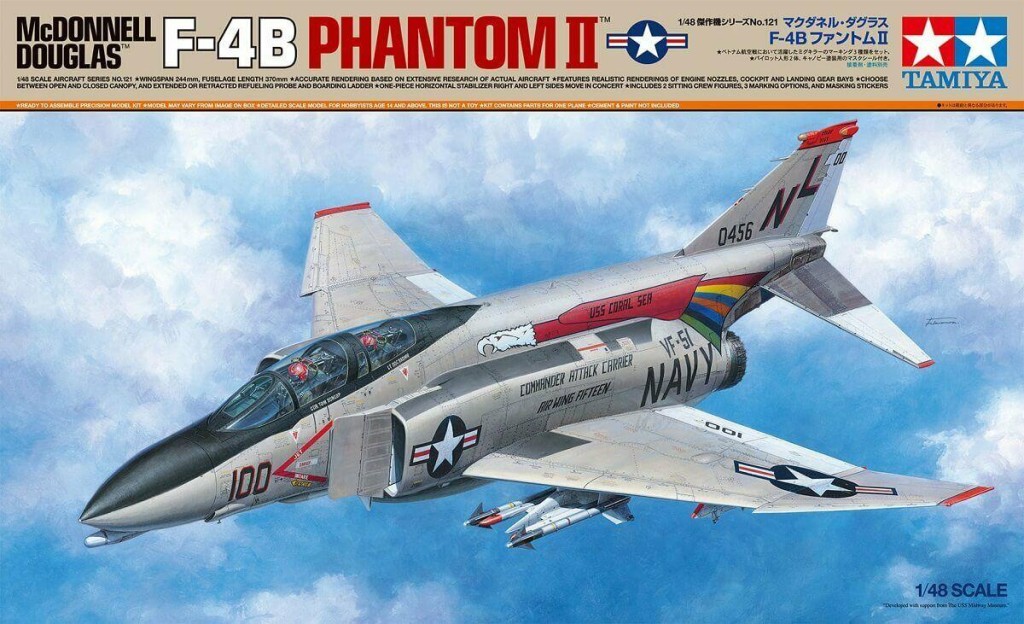
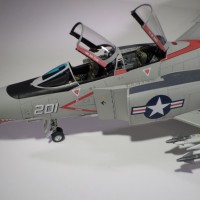
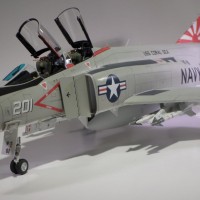
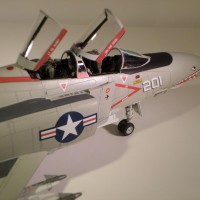
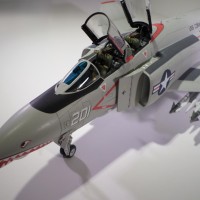
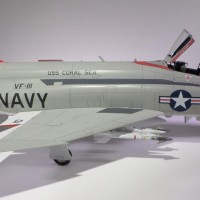
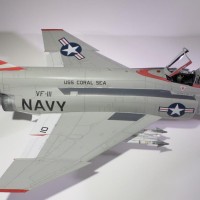
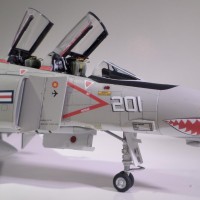
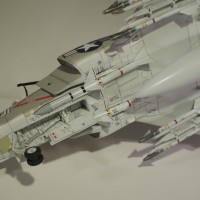


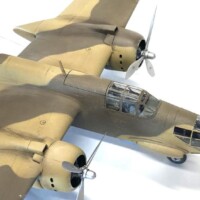
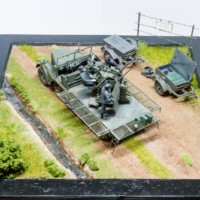
more images
3 attached images. Click to enlarge.
Really, REALLY nice build and finish. All good.
Thanks Bob !
Amazing build, Paul!
Love your chosen scheme!
Thanks Spiros !
Excellent build, Paul @ramair67
Great paintwork.
Thanks John !
Really nice work.
Here's the account of the fight, from my book "The Tonkin Gulf Yacht Club: Naval Aviation in the Vietnam War":
The next Navy MiG kill happened the afternoon of March 6, and the two aircrews from Coral Sea’s VF-111 demonstrated the value of the Top Gun training in maneuvering and teamwork, as they successfully took out a MiG-17 by sticking to the F-4's strong points and putting it into a “sandwich” for the victory.
Section leader Lieutenant James ‘Yosemite’ Stillinger, veteran of a prior combat tour in the F-8 and a recent Top Gun graduate, with RIO Lt(jg) Rick Olin were accompanied by wingmen Lieutenant Garry L. Weigand and RIO Lt(jg) William C. Freckleton, assigned as Force CAP (FORCAP) to support a photo-reconnaissance mission to Quan Lang airfield. Yankee Station had been moved from its previous point some 400 miles from North Vietnam to a point only 150 miles off the coast, which placed the task force close enough to be in potential danger of attack by the VPAF. The FORCAP was assigned to take a position north of the task force to intercept any attempted attack, while also being cleared to intercept any enemy jets that were spotted by the RA-5C when they turned north to return to “safe” airspace in central North Vietnam. Weigand and Freckleton were originally assigned to fly wing for Top Gun “Original Bro” Lt. Commander Jim “Cobra” Ruliffson and RIO Lt(jg) Clark van Nostrand. However, as the Phantoms were holding on the catapults, Ruliffson’s jet sprung a hydraulics leak. Stillinger and Olin, the stand-by, replaced Ruliffson and assumed section lead. Once airborne, both aircraft were discovered to have radar problems, with Olin’s having pulse search problems while Freckleton’s experienced complete failure. The section continued, although only able to employ the four Sidewinders each carried.
The RA-5C was escorted by two F-4s from Coral Sea sister squadron VF-51, led by squadron CO Commander Foster S. “Tooter” Teague with RIO Lieutenant Ralph M Howell, and squadron Operations Officer Lt. Commander Jerry B. “Devil” Houston with RIO Lieutenant Kevin T Moore. Quan Lang airfield had been extensively developed during the bombing halt and now in 1972 was home to 260 VPAF fighters: 135 MiG-17s, 95 MiG-21s and 30 Chinese-built MiG-19s. Recently, the enemy fighter force had been regularly harassing Air Force B-52 missions in Laos, providing cover for the build-up of supplies being positioned in that country for the coming offensive against South Vietnam.
The Red Crown controller aboard USS Chicago was Senior Chief Radarman (RDCS) Larry Nowell, who by the end of the initial Linebacker air campaign in July would be the most successful Red Crown controller, guiding the Navy jets in 13 MiG-killing sorties. Fighter crews called him by name and considered themselves lucky when their missions coincided with his watches. For this accomplishment, Chief Nowell would be awarded the Distinguished Service Medal in August 1972, only the second Navy enlisted man to receive the award during the Vietnam war.
Guided by Nowell, the VF-111 Phantoms arrived on-station above Brandon Bay and took up an orbit. Moments after their arrival, the RA-5C called “Bandits! Bandits! Two Blue Bandits!”. then “More! Red bandits! Red bandits! Two, no I think I see three Red Bandits!”. Adrenaline started pumping at the news there were at least two MiG-21s and three MiG-17s airborne. The VF-51 escorts that had remained over Laos accelerated to join the Vigilante photo plane. They arrived over Quan Lang and were quickly engaged by four MiG-17s. Teague and Howell were able to get in position to launch a Sidewinder against one of the MiGs, that exploded close enough to damage it, but as Teague became involved with the others, he lost track of the jet and the kill was not confirmed. After a real tussle, the two Phantoms managed to evade their more numerous opponents and get out of enemy airspace safely.
They had been up against a flight of MiG-17s from the 923rd Fighter Regiment, led by six-victory ace Le Hai. When the fight broke up, Le Hai and his wingman, Hoang Ich, dived away, low on fuel. The two MiGs took up a course back to Tho Xuan airfield. Minutes later, they ran across two F-4s and engaged in a turning fight until Le Hai realized he was out of ammo, at which point they broke off and headed for Anh Son airfield, which was closer.
Moments after Stillinger and Weigand arrived on-station, expecting from having heard Teague’s and Houston’s radio calls that they might intercept the MiGs returning to their base, Chief Nowell advised them they had “bogeys” in their immediate vicinity. Weigand took position on Stillinger’s right wing as Red Crown then vectored them northwest at 15,000 feet. Nowell informed them they had a “bogey” at 326 degrees and 14 nautical miles, 80 degrees to their right. The controller called the bogey at eight and then six miles, but neither crew spotted the enemy. Nowell then called “Merge plot.” The two were almost on top of the target, but neither crew saw anything. Stillinger called “No Joy! No Joy!” Nowell replied “Look low, look low, three miles.”
Le Hai and Hoang Ich were approaching Anh Son airfield, when Ich looked up and saw two F-4s above them. With Le Hai now extremely low on fuel and headed on to land, Hoang Ich turned back to engage the enemy and cover his leader.
Wiegand remembered, “We rolled up into a left bank, looked down, and there was the MiG! It looked as though he had just pulled his nose up to come after us.” The MiG-17 was at an altitude of approximately 500-1000 feet. Stillinger call “Tally ho!” Moments later Weigand replied, “Roger, Tally ho on one MiG-17!” The two Phantoms were at 3,000 feet in a descending right turn. Freckleton later praised Nowell’s direction. “If he hadn’t told us to look down exactly when he said to, we would have continued our starboard turn and the MiG would have come around behind our section and bagged one or both of us.” Freckleton explained later, “‘We knew it was going to be pretty much an energy fight since the MiG could easily out-turn the F-4. We had to use our speed and energy to climb, dive, extend and pitch back, as opposed to laying on a 6G turn that would not get us inside the MiG’s turn radius.”
Stillinger’s spread of the tactical information he had learned at Top Gun in the squadron was paying off. He directed Weigand to go to trail. Pulling up in “the egg,” Stillinger pitched over the top and positioned himself in trail on the MiG out of a barrel roll. As he descended in a right turn, the enemy fighter suddenly reversed left and pulled up hard into him. Stillinger recalled later, “I don’t know if he saw us or if his GCI said there was somebody behind him, but he turned.” Stillinger was able to follow the MiG through several reversals, but was unable to put his nose on the enemy to fire. Hoang Ich continued to maneuver in the horizontal, turning from 15-20 degrees nose high to 15-20 degrees nose low, as Stillinger remained in the vertical. Each time he came off a vertical roll and started down, Ich reversed course, forcing Stillinger to barrel roll or yo-yo away from the enemy fighter to regain position.
“I finally decided, ‘To hell with maintaining energy’ and decided to pull around the corner and shoot him. I was outside his plane of turn, looking up at him, and I could see his tailpipe. I had a very good tone.” Stillinger pulled the trigger at a range of 4.500-6,000 feet, but the MiG rolled into him, pulling very hard. “That was the first time he really turned to its maximum, much tighter than anything he showed me before.” The Sidewinder tried to tried to turn back, then went ballistic. “I don’t think it ever had a good chance, once the MiG pilot rolled and pulled extremely hard. He blanked out my view of the tailpipe, and I didn’t have a tone on my next missile.”
Stillinger rolled away and came back down, but the MiG turned and put “quite a bit of angle-off in that one turn.” There was no way to get a better shot than what he had taken. Stillinger called Weigand: “I can’t stay behind him. I’m going to unload and run. Do you have me in sight?” Perched to take over the fight, Weigand replied, “I am rolling in on the MiG.”
Stillinger then maneuvered into a pure-pursuit attack, putting his nose on the MiG and lighting the afterburners as he came down. “As I went by him, I went ahead and relaxed the G and rolled away a little bit, almost wings-level, passed 500 feet behind him, then rolled back and pulled so I was sure I could see him. This was where his slow rate of roll was pretty obvious. I went by and he lazily rolled around toward me. It took him so long to roll into tracking position that I think he was outside gun range because I never saw him fire at me.’
Stillinger called Weigand in from overhead as he kept Ich’s MiG at four o’clock low to drag him out. Ich lit his afterburner and tried to close Stillinger’s rear but did not enter a lead-pursuit track. Weigand remembered, “I rolled up over the top of the MiG, then continued around in a left-hand roll, coming out below and behind him. I figured that he was preoccupied with Jim, and hadn’t seen me. He pulled hard into Jim, then, just as I put my nose on him, he straightened up and pulled hard into me! I figured he had now seen me, and was going to come around and start fighting with me. But I pushed down, trying to get into his blind six, and the reversed back onto the flight lead, who was now directly in front of him. He hadn’t seen me after all!
“When I had first rolled in on him I had a lot of excess airspeed, and started to overshoot. To correct, I went to idle and put the speed brakes out. As he reversed onto the lead, he lit his ’burner and got his speed up pretty good. I got the speed brakes in. He was fairly close to Jim, but his reverse had cost him position. We were down to 500 ft and Jim was pushing 600 knots and opening on him pretty fast. He must have thought he had a chance at a gunshot though, and that’s why he lit his ’burner and continued to jockey for position.”
Seconds later, Stillinger called, “Okay, the MiG is now back at my right four o’clock. Shoot him, shoot him. We’re holding him off.” Weigand was directly behind the MiG and fired an AIM-9D. It went directly up the enemy’s tailpipe and exploded. Several large pieces of the tail came off as the MiG flew straight ahead for a moment, then pitched over to crash and erupt in a fireball.
Villagers at the February Third State Farm in Quy Hop, Nghe An Province, reported that the MiG-17 crashed near their village and caught fire without the pilot escaping. In the meantime, two MiG-21s of the 921st regiment, flown by Bui Duc Nhu in leader with Nguyen Van Nghia as wingman were ordered to take off from Anh Son and engage the enemy.
Moments after scoring the kill, Red Crown alerted the flight to more MiGs. Weigand recalled, “By this time the North Vietnamese Air Defence Controller had vectored MiG-21s onto us. They were only about 15 miles away, and closing fast. We were low on fuel and couldn’t afford another engagement, so we lit the ’burners and exited North Vietnam, supersonic at 1,200 ft, outdistancing them.” Once they were safe, the two Phantoms rendezvoused with a KA-3B to take on fuel before returning to Coral Sea.
Weigand and Freckleton’s kill was Coral Sea’s first victory since VF-151 had claimed a MiG-17 on October 6, 1965. It was the second kill for F-4B BuNo 153019, which as NH-110, flown by VF-213's Lieutenant Dave McRae with RIO Ensign Dave Nichols, had shot down an AN-2 on December 20, 1966. The fight had been a perfect demonstration of the “Loose Deuce” teamwork devised at Top Gun to out-fly and out-fight the MiG-17 by never engaging the enemy on his terms.
Thanks Tom, interesting excerpt from your book also proves the value of Top Gun. Thanks again!
Nicely done! I am just about to start on mine
Thank you Rob !
Very nicely done! Well executed, sir.
Thank you Gavin !
Great work, who needs You Tube reviews when you have builds like this?
Thanks George !
Excellent work and well executed. And thanks for the excerpt on the mission. I have the old squadron book ...And Kill Migs and their story is in it as well but I don't think as detailed.
Thanks David !
A beautiful Rhino! I have a set of decals to do those same markings in 1/72.
Thanks Greg!